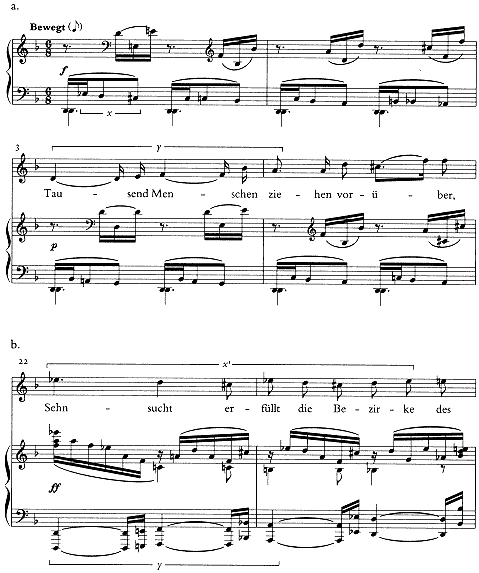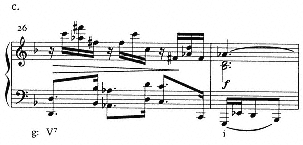After the D-Minor Quartet
The completion of the D-Minor Quartet was followed by a period of Lieder composition almost as intense as that of 1903-4. If the compositional energies of songs like Verlassen can be said to have been channeled into op. 7, those of the quartet itself seem to have flowed out into the group of songs from the fall of 1905, including Alles, op. 6, no. 2 (6 September 1905); Der Wanderer, op. 6, no. 8 (15 October); Am Wegrand, op. 6, no. 6 (18 October); Lockung, op. 6, no. 7 (26 October); and Mädchenlied, op. 6, no. 3 (28 October). Also drafted at this time was the fragmentary programmatic piano quintet, Ein Stelldichein, based on a Dehmel poem (published as Schoenberg 1980).[29]
Schoenberg claimed to have composed the Dehmel song Alles "very fast," while waiting for music paper with which to finish copying the D-Minor Quartet.[30] It is remarkable for its use of invertible counterpoint in the manner of op. 7 and for the extremely ambiguous tonal language, which settles into the tonic

Similar contrapuntal preoccupations are joined to a much more expressive language in Am Wegrand. The poem, by John Henry Mackay, which communicates alienation and despair in a manner not unlike Conradi's Verlassen, called forth an equally powerful response from Schoenberg. Am Wegrand shares the key of the quartet, D minor, and the wide-ranging, athletic opening melody of the voice seems cut from the same cloth as the main theme of op. 7. As in Verlassen, Alles, and the D-Minor Quartet, this melody forms part of a contapuntal complex that
[29] It has been claimed by Allen Forte (1978, 138) that "set consciousness"-that is, an intentional use of unordered pitch-class sets-begins for Schoenberg with the op. 6 songs composed in the fall of 1905. Forte bases his suggestion principally on what he analyzes as a frequent recurrence in the songs of Schoenberg's "musical signature," a six-note set made up of the pitch equivalents of letters from the composer's last name. Forte's analyses seem to me farfetched, in that to find the signature, he must often acknowledge complementation, transposition, and inversion of the set, atonal operations with which Schoenberg is not likely to have been acquainted at this time.
[30] See Newlin 1980, 63. Schoenberg does not mention Alles by name here, but it seems clear from the context of his remarks that he is referring to this song; there is no other song that corresponds in time to the final stages of the completion of the quartet in fall 1905.

Example 8.20
Am Wegrand , op. 6, no. 6.

Example 8.20
continued
is subjected to inversion. From the three-note descending chromatic motive in the piano left hand (

Other similarities to the quartet are evident in Schoenberg's treatment of the main key. The opening bass motive, x, circumscribes the tonic D by semitone, a feature elaborated in the vocal version of the motive, x'. The upper half-step,



The introduction of the whole-tone complex in Am Wegrand is also related to procedures in op. 7.


Schoenberg's creative rhythm in the period 1903-6 seems to have dictated an alternation between Lieder and instrumental works. The achievements of the
songs of late 1905-the integration of whole-tone with diatonic-chromatic procedures in Am Wegrand; the contrapuntal intricacy of Alles; the "fluctuating" tonality, as Schoenberg called it, of Lockung, a song that "expresses an tonality without once in the course of the piece giving an triad in such a way that one could regard it as a pure tonic" (Schoenberg 1978, 383)-all these techniques were adumbrated to some degree in the D-Minor Quartet. They were to be carried over, in imaginative ways that Schoenberg himself could not have envisioned in 1905, into his next large-scale project, the First Chamber Symphony.